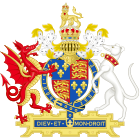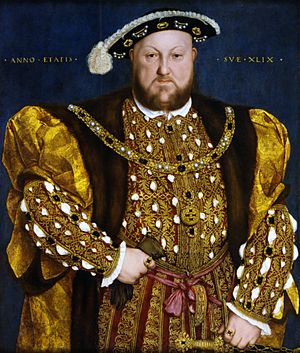Statute of Uses facts for kids
| Act of Parliament | |

|
|
| Long title | An Act concerning Uses and Wills. |
|---|---|
| Citation | 27 Hen. 8. c. 10 |
| Other legislation | |
| Repealed by | Law of Property Act 1925 |
| Relates to | Statute of Enrolments Statute of Wills |
|
Status: Repealed
|
|

The Statute of Uses (enacted in 1536) was a law made by the Parliament of England. It changed how "uses" worked in English property law. A "use" was a way for someone to control land without legally owning it. This law stopped people from creating new "uses" for land. Instead, it made the people who benefited from a "use" the actual legal owners of the land. This meant they had to pay taxes on it.
King Henry VIII of England came up with this law. He wanted to solve his money problems. Back then, land ownership was taxed through something called "seisin" (meaning possession). But "uses" allowed land to be passed around without paying these royal taxes. Also, land usually couldn't be passed down through a will. When an owner died, the land went to their heir and was taxed. So, people started using "uses" to give land to someone other than their legal heir or to avoid taxes.
The King first tried to pass a similar law in 1529. But members of the House of Commons stopped him. Many of them were landowners who would lose money, or lawyers who earned fees from the confusing "uses" system. Experts aren't sure how the Commons were convinced later. But new bills were introduced in 1535 and finally passed in 1536 by both the Lords and Commons.
The Statute of Uses made all "uses" invalid unless a trustee had an active job to do. The people who benefited from the "use" became the legal owners and had to pay taxes. This law partly led to a rebellion called the Pilgrimage of Grace. More importantly, it helped create modern trusts. Experts disagree on how effective the law was. Most agree it was very important. For example, historian Eric Ives said it "revolutionized" English land law. But some say it actually made it easier to hide land ownership in some ways.
The Statute of Uses is still a valid law in some parts of Canada today.
Contents
Why Was This Law Needed?
In old England, you couldn't usually pass down land through a will, except for land in cities. Instead, people used "uses." This meant a landowner could give their land to one or more "feoffees" (people who held the land for them). These feoffees would then manage the land as the original owner wished.
However, "uses" were often seen as tricky and could be abused. A famous legal expert, Edward Coke, once said that "Fear and Fraud" invented "uses." People used them to protect their land during wars or to avoid paying debts, taxes, or other fees. Sometimes, there were many feoffees for one piece of land. This made it very confusing to figure out who owned the land after a lord died. A famous case involving Sir John Fastolf lasted for 17 years!
While these problems needed fixing, King Henry VIII's main reason for the law was to get more money. For years, Henry had struggled to raise enough money. His royal lands didn't provide enough income. Taking loans or special taxes would make him unpopular. So, increasing his royal income from land was the best choice. He focused on land law, which was very complex. He wanted to change it to help his finances. "Uses" were hurting his income because they avoided the traditional royal taxes collected through "seisin" (possession of land).
Early Attempts to Pass the Law
In 1529, two new laws were proposed to Parliament. The first law was very strict. It aimed to get rid of "uses" almost completely. It also wanted to end "entails," which were rules about how land had to be passed down in a family. This would make all land ownership "fee simple," meaning it could be fully owned and sold. However, powerful nobles were still allowed to have entails. Also, no one could buy such land without the King's permission. These rules were meant to get the nobles' support for the second bill. The second bill would give the King control over the land of noble orphans. When an orphan grew up, the King would get a year's income from a third of their lands.
This plan was okay with the barons and other high-ranking nobles. But it needed to pass the House of Commons. Many large landowners in the Commons felt the law would stop them from making secure wills. Lawyers saw it as taking away their valuable business by making land cases simpler. Since these groups made up most of Parliament, the King's plans failed that time.
In 1532, Henry tried again. But the Commons still resisted. Henry then tried to win over the lawyers. Many lawyers agreed that "uses" made fraud easy. Also, common law lawyers were a bit jealous of the Court of Chancery's power over "equity" (fairness in law). They wanted to reduce that power. So, Henry decided to scare them a bit. He listened to complaints about court procedures and lawyers' fees. He even talked about setting limits on how much lawyers could charge. Some historians believe this made the lawyers side with Henry, leading to the law's passage. However, others disagree. They argue that many lawyers were also landowners and would lose more money personally than any fee reduction would cause. Also, lawyers probably weren't a big enough group to pass a bill alone.
How the Law Was Passed
In 1535, three new proposed laws were given to Parliament. These were about "uses" and "wills." There was also one about "Enrolments." From these proposals came the Statute of Uses and the later Statute of Enrolments.
The three proposals about "uses" offered two different ways to solve the problem. The first idea was to severely limit when "uses" could be created. It said that "uses" would have no legal effect unless they were clearly stated when created. No agreement over land could change its "use." This plan would have stopped most of the bad things about "uses." But it would also have made property law very rigid. It wouldn't stop people from getting rid of land through a "devise" (a gift of land by will), so it wouldn't help the King's money problems much.
The second, more complex idea, was in the other two proposals. This idea simply removed the concept of an "equitable interest" in land. It left only the idea of a "legal interest." This kept "uses" but made them legal. It also kept property law flexible instead of making it too strict. Parliament eventually chose this second idea. The bill became law in April 1536 as the Statute of Uses. So, all "uses" became invalid unless they required a trustee to perform an active duty. The people who benefited from the "use" were then considered the legal owners, and they had to pay taxes.
The Statute of Uses also said that a widow could not have both "jointure" (property given to her by her husband) and "dower" (her legal right to a part of her husband's land). Before, the Statute had made this possible.
What Happened After the Law?
Right away, the Statute partly led to the Pilgrimage of Grace. This was a rebellion where people demanded an end to Henry's religious changes and also wanted the Statute of Uses to be cancelled.
More importantly, the Statute led to the development of the modern trust. A trust is a legal arrangement where one person holds property for the benefit of another. While the King wanted the Statute to stop people from passing land by will ("devises"), some experts argue it failed. For example, if someone gave land "to the use of such person as I shall appoint by my will," this created a "use" without formally creating a legal estate. This land was held on a "lease," not as full ownership. Because of this, it wasn't affected by the Statute of Uses, which banned other methods. So, some argue that the Statute actually helped keep "devises" alive and even gave them more power.
The Statute's goal was to make property law more open. But its actual impact sometimes made it easier to hide who owned property.
At first, some people didn't think much of the Statute. They said it only added "three words to a conveyance" (a legal document for transferring property). But lawyers at the time and in modern times understood its importance. Decades later, famous legal minds like Francis Bacon and Edward Coke studied it closely. In 1879, historian Maitland joked that it was a law through which "whole judicial processions" had passed. He called it a "Statute of Abuses" rather than "Uselessness." On the other hand, William Holdsworth called it "perhaps the most important addition that the legislature has ever made to our private law." Eric Ives also wrote that its importance is "beyond doubt" and that it "revolutionized" English land law, leading to the "crucial doctrines of the trust."
When Was the Law Ended?
The Statute of Uses was officially ended by the Law of Property Act 1925. This happened after it was first mentioned as repealed by the Law of Property (Amendment) Act 1924.
Even though it was repealed, the Statute of Uses still affected land dealings that happened before the Law of Property Act 1925 came into effect.
The Statute of Uses is still a valid law in some provinces of Canada today.
See also
- Feu
- Quia Emptores (1290)
- Statute of Wills (1540)
- Statute of Frauds (1677)
- Cestui que

